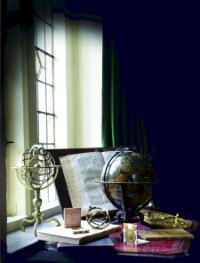The most famous graduate from Gemma’s workshop was his pupil and later collaborator, Gerard Mercator, who became the greatest cosmographer of the 16th century. It was appropriate for someone with a background in the Louvain tradition that Mercator made maps, terrestrial and celestial globes, and astronomical instruments such as astrolabes, thus encompassing a wide range of the craft of cosmographical astronomy. He also took the cosmographical book further than his predecessors, introducing the name ‘atlas’ for the result.
Although it is appropriate that Mercator is most commonly remembered for the geometrical projection used for his world map, which gave the world what is still its most familiar image of itself, it is important for this exhibition to extend this appreciation to his globes and instruments. Such work was not an exception to astronomical practice, rather it was typical of what it meant to be a working astronomer in the 16th century.
Featured Objects
17. Terrestrial and celestial globes by Gerard Mercator, 1541, 1551
18. Gerard Mercator’s copy of Nicolaus Copernicus, De revolutionibus orbium coelestium (Nuremberg, 1543)
27. Polyhedral dial by Nicolaus Kratzer, London, c.1525
29. Astrolabe by Thomas Gemini, London, 1559
30. Tycho Brahe, Astronomiae instauratae mechanica (Nuremberg, 1602)
Previous Panel: Gemma Frisius in Louvain

